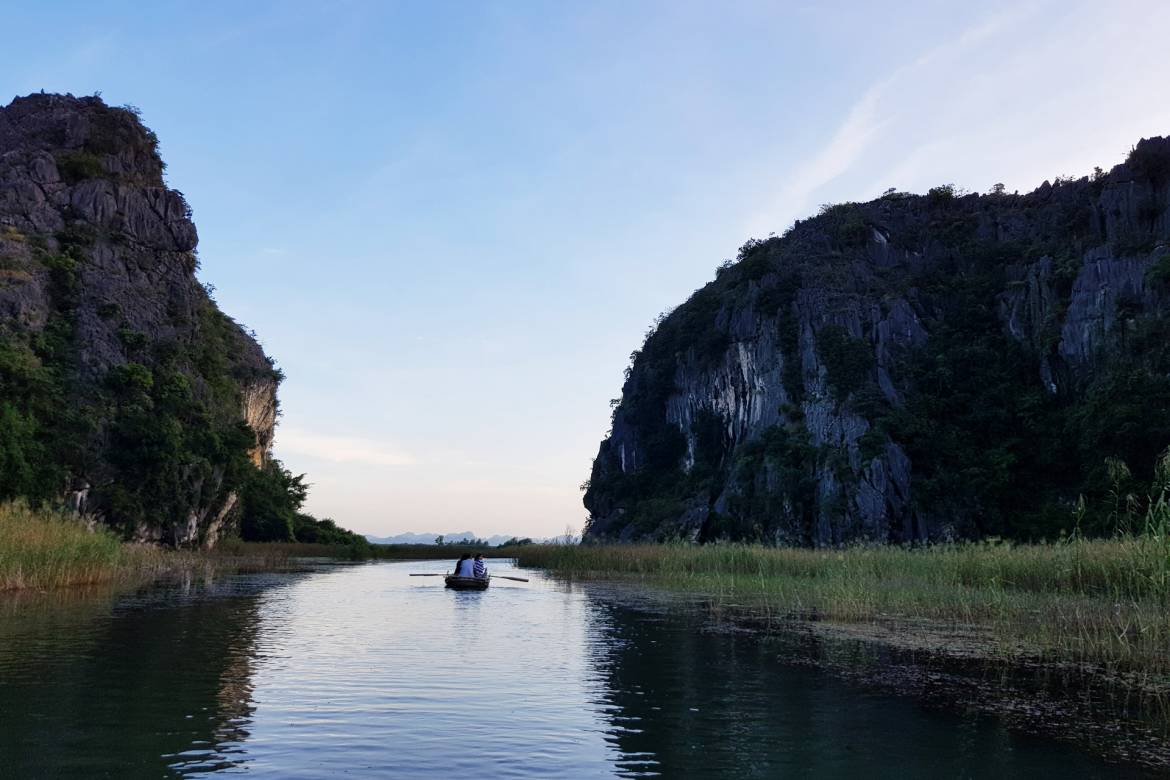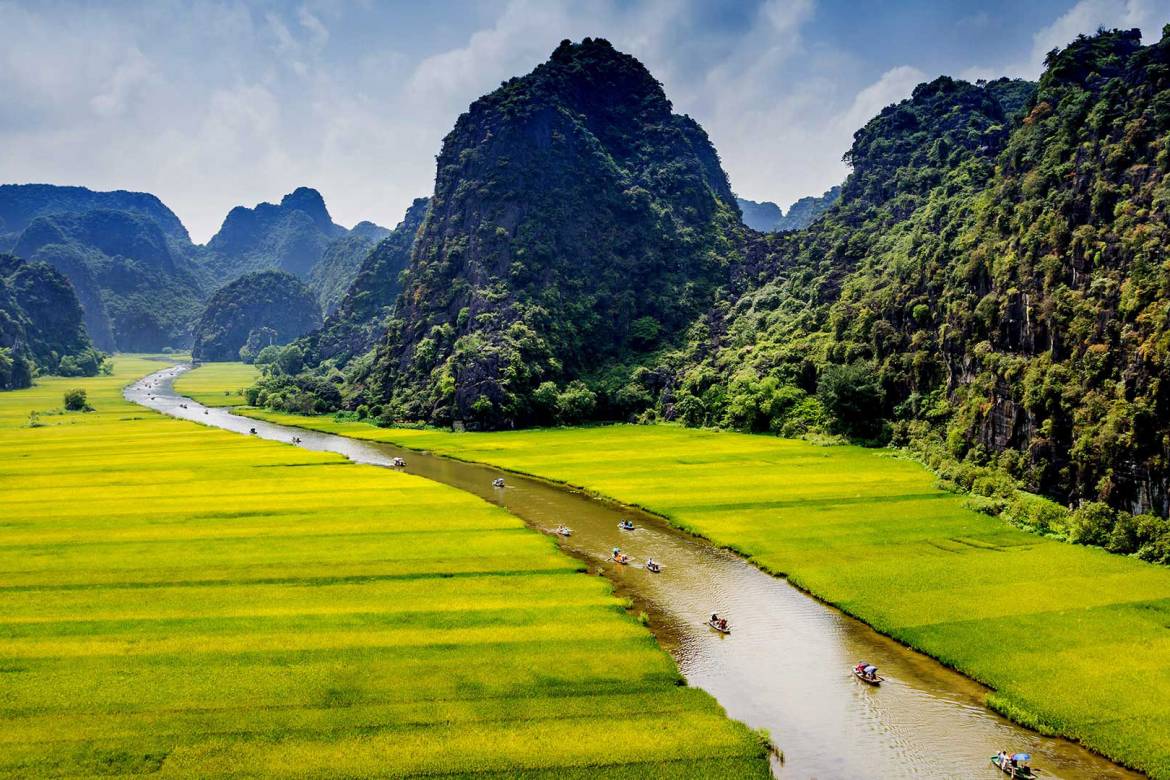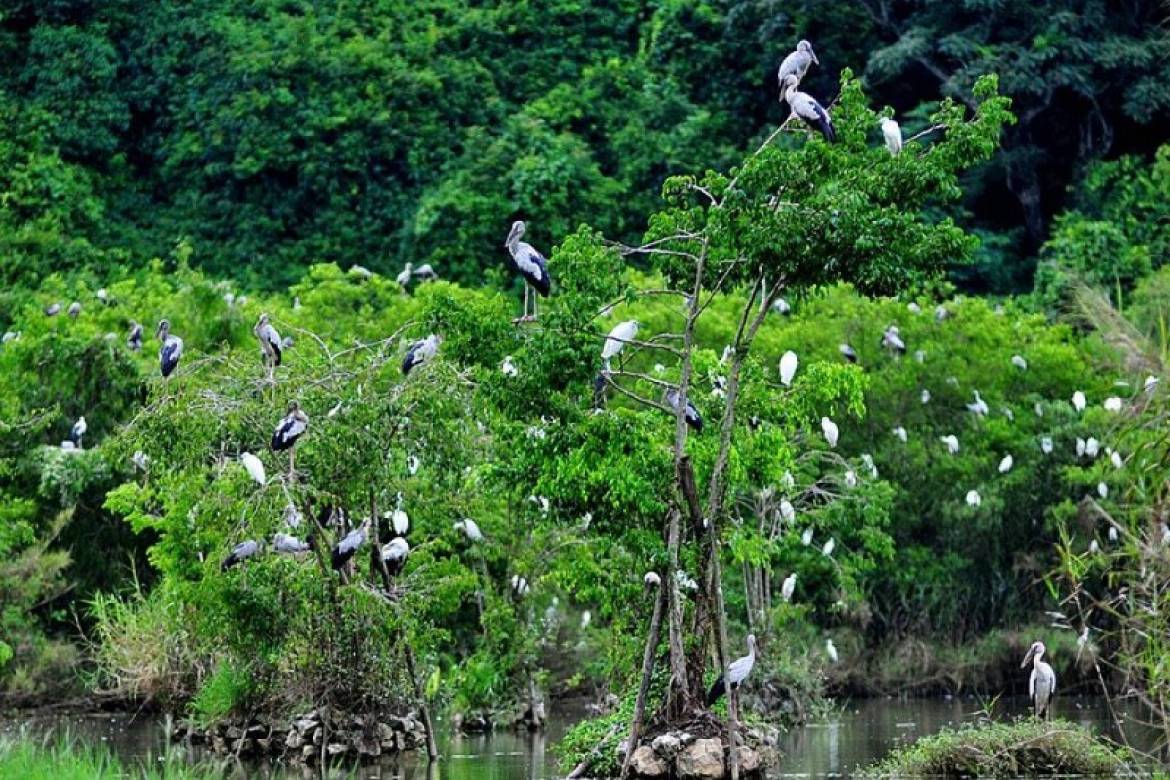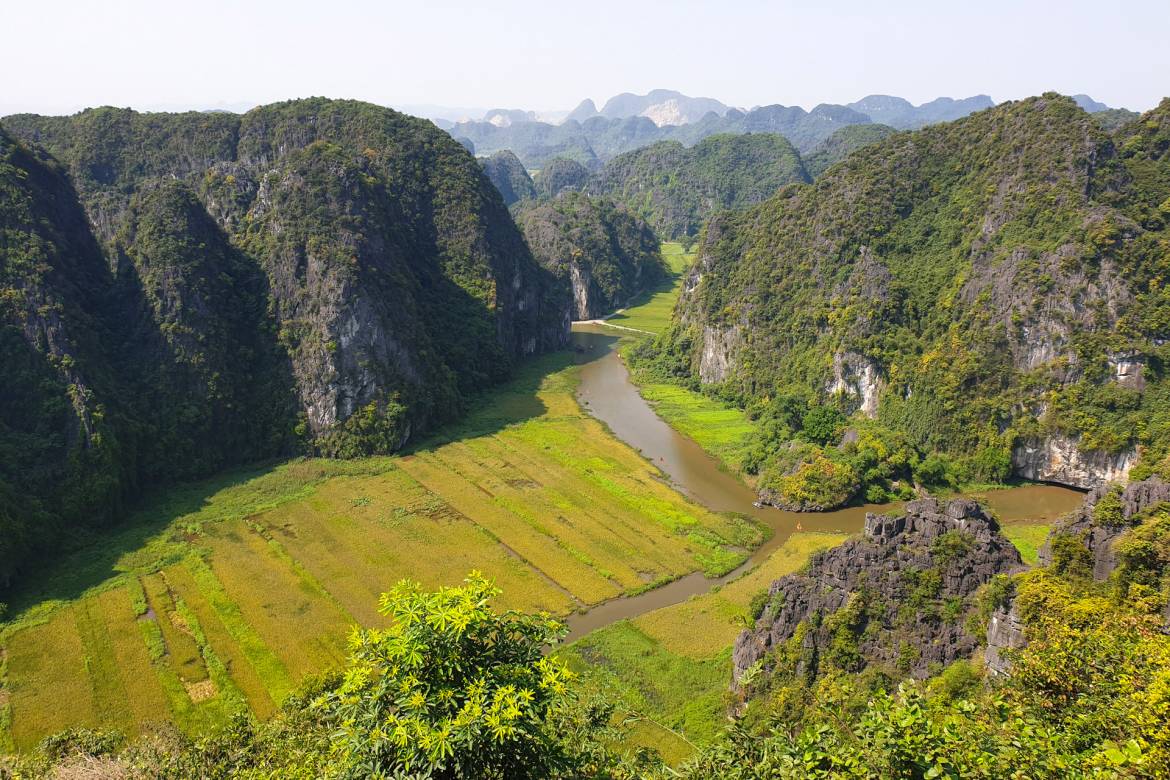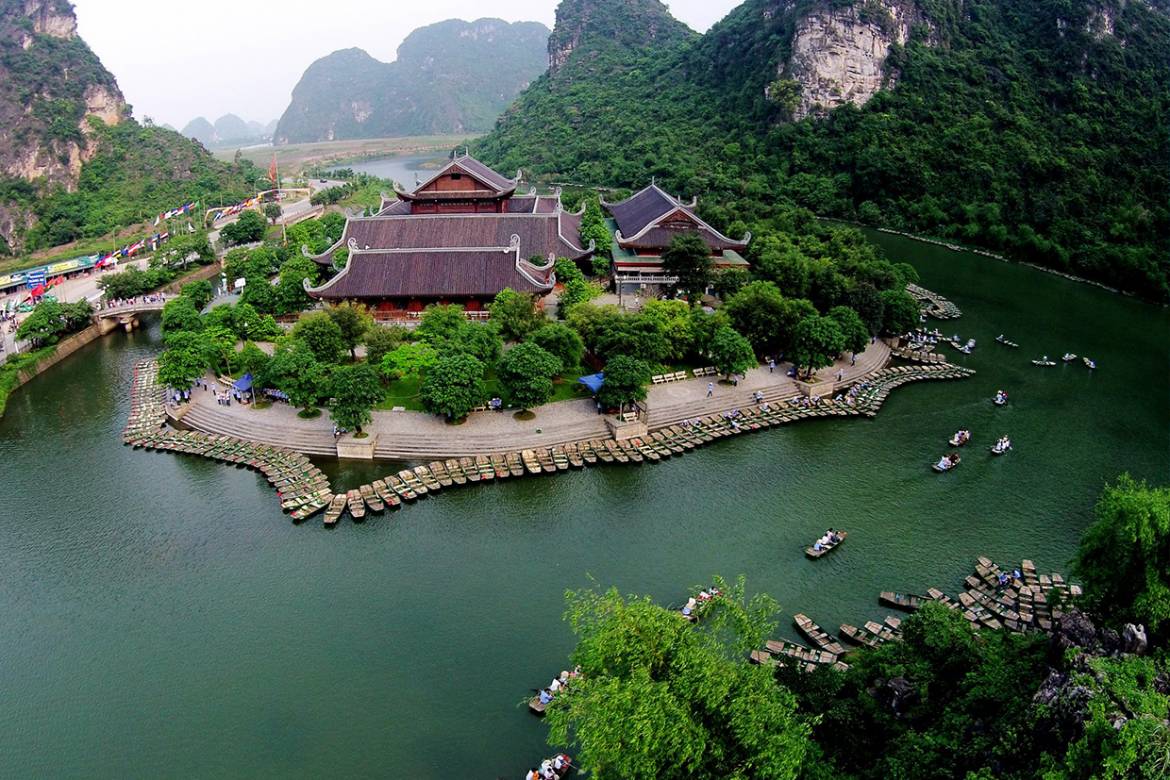Fares for visiting:
* Electric car service: VND 30,000 / person / turn
* Visiting stupa: 50,000 VND / person
* Tour guide + electric car: 520,000 VND / person
Bai Dinh pagoda tourist area is open from 6 am to 9 pm, all days of the week. It is about 3.5 km from From the gate of Bai Dinh pagoda to the center. You can choose to walk and take electric car, the car runs continuously and tickets are sold right at the bus station.
Bai Dinh tourist area has two areas: the ancient Bai Dinh Pagoda and the new Bai Dinh Pagoda
THE ANCIENT BAI DINH PAGODA
The ancient Bai Dinh Pagoda (Bai Dinh co tu) is far about 800 meters from Tam The Hall to the South. This pagoda is facing the west, located near the top of a rather quiet mountainous area, including a front house (tiền đường) in the middle, turning to the right is the light cave for worshiping Buddha, next is Cao Son Temple near the end of the back door of the light cave; turning to the left is the shrine of St. Nguyen and next is the dark cave for worshiping Mother and Fairy. According to the Eastern opinion, the pagoda is in the region gathering many talents, which is the land of birth of the King, the Saint, and the Gods. Although the pagoda has a history formed from the Dinh dynasty with Cao Son temple in the west of Hoa Lu four gods, Bai Dinh ancient temple has many details of architecture and antiquities bearing the bold imprint of the Ly Dynasty.
Light Cave – Dark Cave
To visit the cave in Bai Dinh mountain, you have togo over 300 stone steps, through the three-entrance gate halfway on the mountain. At the top of the slope is the turning point: the right is the bright cave for worshiping Buddha and God, and the left is the dark cave for worshiping Mother and Fairy. Above the door of the light cave, there are 4 words, "Minh Dinh Danh Lam" engraved on stone which was awarded by Le Thanh Tong, meaning: "Save famous name and beautiful landscape".
The cave is 25m long, 15m wide, with an average height of 2m. The foundation and ceiling of the cave are flat. Going next to the cliff on the left end of the cave will lead to a bright and wide cave gate and a green valley appears. If continue going down to the stone steps, it will lead you to Cao Son temple. Back to the turning point at the top of the slope, turn left about 50m will be the Dark cave.The Dark cave is larger than the Light cave, including 7 chambers with caves in the top and caves in the depth, the caves are connected through many rocky crannies, there are caves with flat foundation or sunken foundation like a hollow, there are caves with flat ceiling, there are caves with a stalactite ceiling hung down in many forms given by the nature. In the dark cave, there is a Pearl well formed by cold water falling from the ceiling. The Fairies are worshiped in many crannies in the cave.
Temple for worshipping Nguyen Saint
Ly Quoc Su Nguyen Minh Khong is the founder of Bai Dinh Pagoda. He was a famous Buddist priest, magician who was conferred the title Teacher by the King and venerated as Nguyen Saint by the people. Dinh mountain is located 4 km from the homeland of St. Nguyen Minh Khong. Legend has it that when he came here to find herbs to cure "tiger products" for King Ly Than Tong, he discovered beautiful caves and built a temple to worship Buddha and a precious medicinal garden to cure people.The Nguyen temple is located right at the turning point of the slope top, built in the style of leaning against a mountain, his statue cast in bronze in the temple
Teacher Nguyen Minh Khong was a person bringing mapping of the Ly dynasty. He had learned and collected folk medicine knowledge, found medicine every day in the Biopharmaceutical Garden, but became a famous physician and cured the strange disease for the King. He also collected and revived bronze casting - the quintessence of Dong Son civilization - ancient Vietnamese civilization that became a bronze casting patron saint. He took pains to find good teachers for studying, so that a monk in Trang An province becomes a Teacher of the Prince in the imperial city, ranking first among domestic Buddhist monks and nuns, his fame and dharma reached the pinnacle. His conduct behavior reflected the atmosphere of the mystical, bizarre, eclectic Ly dynasty Buddhism but contributed very positively to the revival and development of Vietnamese national culture in many aspects. : philosophy, literature, architecture, fine art, industry ... as the foundation for the development of Vietnamese culture in the future.
Temple for worshiping God Cao Son
At the end of the light cave, there was a path leading down to the valley side of the dalbergia tonkinensis prain forest. In misery Dinh Bo Linh was brought to live next to the temple of gods in the cave by his mother. When building Hoa Lu capital, the King Dinh Tien Hoang De also built three temples to worship the gods defending in three circles of the citadel that the people called Hoa Lu four gods.Accordingly, the god Thien Ton defended the entrance to the Eastern citadel, the god Quy Minh defended the entrance to the Souther citadel and the god Cao Son gods defended the entrance to the Western citadel.Currently, Cao Son temple is built with an architecture almost similar to that of St. Nguyen temple, also leaning against the mountain, with a corridor separating the valley in front. According to legend, god Cao Son is one of 50 children of Lac Long Quan - Au Co. The main temple of the god is in Phung Hoa (Nho Quan, Ninh Binh). This god had the merit of assisting Le Tuong Duc army to destroy Uy Muc, then he was also worshiped by the people of Kim Lien village and was bestowed Cao Son Royal Highest defending the Southern Citadel, one of Thang Long four gods.
According to stories of gods of Hau mountain temple (Yen Thang commune, Yen Mo, Ninh Binh), Cao Son Royal Highest was the Military Chief Vu Lam, the 17th son of Lac Long Quan king, when patrolling from Nam Linh to Thien Duong of Vu Lam Royal step-over place, he found a plant with powder on its trunk used to make cakes instead of rice flour and took his name for the tree, Quang lang (local people still call quang lang tree or bung bang tree). The god had taught and helped the people to win their bread while protecting them from destructive forces, therefore many temples have been established to worhsip him.The God Cao Son along with the God Thien Ton and the god Quy Minh are the three gods who defendat the three entrances in the west, east and south of Hoa Lu ancient capital.
Pearl well
The Pearl well of the ancient Bai Dinh pagoda is located near the foot of Bai Dinh mountain. It is said that this place where Zen teacher Nguyen Minh Khong took water to decoct medicine for curing people and the King Ly Than Tong. The well was built in moon image, it is very wide, with a diameter of 30 m, the water depth is 6 m and never runs out of water. The wellhead is built with stone handrail. The region around the well is square, with an area of 6,000 m², 4 corners of 4 octagonal floors.
THE NEW BAI DINH PAGODA
Three External gates
Bai Dinh Pagoda has three high and wide external gates built.This isthe symbol for the three doors to enter the temple. Each external gate has 3 doors, built with reinforced concrete and tiled with stone outside, with four small curved roofs with stones above.
Three Internal gates
The internal gate is built entirely of Tu Thiet wood, height of 16.5m, length of 32m, width of 13.5m. The internal gate has four pillars, each of which is 13.85m high, 0.87m in diameter and weighs about 10 tons. The internal gate has 3 floors with curved roofs on four sides, roofed with Bat Trang tube-glazed deep brown tiles. In the gate, there are 2 bronze colossal statues, each of which is 5.5m high and weighs 12 tons.
The Arhat Corridor
The Arhat corridor is designed entirely of wood, the roof framings are structured in the form of "gia chieng chong ruong con nhi", consisting of 2 rows, 3,400m long with 250 compartments, the size of each space is 4.5m x 4.5m . Along the left and right corridors, there are 500 Arhat statues made of monolithic stone, which are hand-made by the craftsmen of Ninh Van stone village (Hoa Lu - Ninh Binh).Each statue is 2-2.5m high, weighs about 2-2.5 tons. Each statue reveals a different form, appearance, expressing the Taoist philosophy with pleasure, anger, love, hate in everyday life of people. The Arhat Corridor was confirmed by the Asian Record Organization as: "The longest Corridor with 500 Arhat statues".
Bell tower
The bell tower is built of reinforced concrete with wooden imitation, architecture of ancient bell tower, octagonal shape, with 3-storey curved roofs, roofed with Bat Trang tube-glazed deep brown tiles. The bell tower is 22m high, 17m in diameter, bearing the appearance of a lotus.
There is a bronze bell weighing 36 tons hung inside the bell tower, cast by craftsmen in Hue. The bell has been granted by the Vietnam Record Book Center with the Certificate of the record: "The largest bell in Vietnam". Below the bronze bell, there is a bronze drum cast according to Dong Son bronze drum model, weighing 13 tons, the diameter of more than 6m and the height of nearly 7m.
Bodhisattva Hall
The Guanyin Bodhisattva Hall is is built entirely of tu thiet wood. including 7 compartments, 14.8m high, 40.4m long, 16.8m wide. The middle compartment of the hall has the statue of Bodhisattva Avalokitesvara with a thousand eyes and thousand arms casted in gold-plated copper, weighing 80 tons, 9.57m high. The statue has been certified by the Vietnam Record Book Center as: "The biggest bronze Bodhisattva Avalokitesvara statue in Vietnam".
Life release lake
The life release Lake has a width of 63m, a length of 77m and an area of nearly 5,000m2. The lotus is planted in the lake. Lotus is the symbol of Buddha and Nirvana. The lake in lower is negative, the temple in upper is positive. Therefore, Life release lake produces harmonic yin and yang, fantastic "water in front, moutain behind" scenes.
Phap Chu temple
Phap Chu Temple of Banh Dinh pagoda worships the Great Buddha, the whole building is made of massive reinforced concrete with wooden imitation. Its height is 30m, 44.7m in length and 43.3 m in width with an area of 1,945 m, including 2 storeys of curved roof. There are 8 roofs on the four sides and a “Co Lau” row to raise the altitude, take light and make ventilation, the edge height is up to 1.3m, the edge roof is 2.6 m high, the moon face in the peak of the roof is only 4.4 m high and the head is 3.3 m high.
In Phap Chu temple of Bai Dinh pagoda for worshiping the Great Buddha, there are three door painting in fresco, three horizontal lacquered boards, and parallel sentences (sentences made of bronze with words and textures), they all praise the merit of the Buddha and the beauty of the temple. These are the products of human intellect, also the Buddhist cultural heritage, national culture of our country: These sentences are also the longest and largest in Vietnam.
Phap Chu temple has 5 compartments. in the middle compartment, there is the statue of Sakyamuni Buddha sitting on the lotus thron and praying the lotus flower with10 m in height, 100 tons in weight. This statue is confirmed the record "The largest bronze Sakyamuni Buddha statue in Vietnam"
Tam The temple
Tam The Temple is also constructed of reinforced concrete with wooden imitation, with 3-storey curved roofs, including 12 roofs on four sides. All roofs are curved, roofted with Bat Trang tube-glazed deep brown tiles. The corners of the roof all have a curved blade like a phoenix tail, which makes the roof bend, smooth and harmonious like a tidal wave, like a boat floating in the water, like two wings of birds spread out to fly. In the Tam The temple, there are 3 bronze statues of Tam The Buddha (past, present and future) of 7.2 m high, weighing 50 tons are placed. They are confirmed with record: "The temple has the largest bronze statues of Tam The Buddha in Vietnam".
From the yard, there are two entrances to the Tam The temple in Bai Dinh pagoda, with a width of 8m for each entrance, including 32 stone steps according to the height from the yard to the porch of 4m. Between the two entrances, there is a square stone relief, with 10m distance in each direction, an area of 100m2 and assembled with many flagstones with the thickness of 0.2m. On the four corners of the stone relief, two phoenixes are carved in the upper, one tortoise is carved in the right lower, one kylin is carved on the left, the middle is the wide moon face with a winding dragon carved inside. This large stone relief is carved with the four sacred mythical creatures.
Bodhi Garden
Bai Dinh is the temple with the most Bodhi trees in Vietnam. On May 17th, 2008, on the occasion of the United Nations Day of Vesak in Vietnam, 100 Bodhi trees engrafted from Indian Bodhi were planted by Vietnamese and World leaders in the temple grounds.
Stele house
The stele house is composed of 55 compartments, mainly recording the names of donators for building Bai Dinh Pagoda. To the West, East and South, each side has 18 compartments, with a stone steel on the stone turtle's back. Each stele is placed on the back of the turtle with 2.9m high, 1.45m wide, 0.40 m thick. The stone turtle has the length of 2.95m long, the body width of 1.70m wide, thickness of 0.97m . Each stele is placed on the back of the turtle with 2.9m height, 1.45m width, 0.40 m thickness. The stone turtle has length of 2.95m, its body width of t 1.70m, 0.97m thickness. The stone stele in the middle compartment is placed on the highest dragon throne with 6,9m high (including the throne), 3.5m wide, 0.6 m thick.
Statute of Maitreya Buddha
Maitreya Buddha statue is located on the top of the highest hill in the temple area, in the height of 100 meters from temple yard. It is the Maitreya Buddha, casted in bronze in the posture of incarnation into a monk who goes to beg. The statue is 10 m high and weighs 80 tons.
Bao Thap of Bai Dinh pagoda
With a height of 100 m, 13 storeys, with an elevator and 72 steps, the stupa at Bai Dinh pagoda is a place to display Buddha sariras from India.


